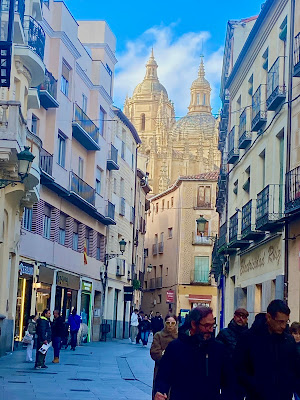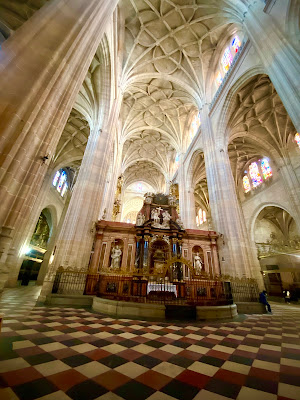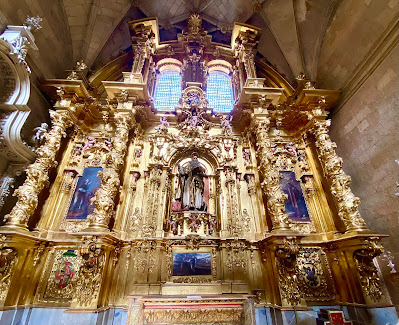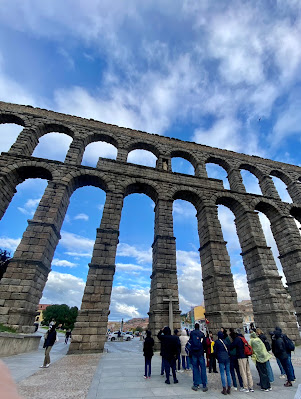Traveling broadens your horizon. It enriches your mind and your spirit. But traveling uses up a lot of your time and treasure. It would be a waste if you missed something on your trip you should’ve seen or experienced. It happened to me several times and I regretted that so much. If you’re planning a trip, I’d like to help you avoid missing out. So, let my blog show you what to look out for. Prepare for your trip by traveling with me through this post. Or you might still be in the praying and dreaming stage. Manifesting your dream into reality starts here!
A
Happy Solo in Segovia, Spain
Do you have a favorite
travel dining memory? A one-of-a-kind culinary experience that deserves a page
one feature in your album. One that made you squeal at the surprising
presentation. One that still makes your taste buds swoon just remembering that
first bite.
Let me show you mine.
Savoring
Segovia’s Cuisine
When I posted this video
on Instagram, I was floored when it garnered more than 13 thousand views. I
guess people found it as attention-grabbing as I did. Make sure you watch till
the end for that “Ayyyy!!!” moment.
From Madrid, we
traveled for more than an hour to Segovia and arrived past noon. We held our wonder
at bay for the imposing aqueduct Segovia is famous for until we can calm our
grumbling stomachs. Our mouths were already watering in anticipation of lunch. The
itinerary said cochinillo (suckling pig) will be served!
The restaurant, El
Bernardino, was jampacked inside and even had a crowd waiting outside – a good
indication that people like their food. Lucky for our group, we had reserved tables.
Anticipation was high when
Peppa Piglet was rolled in. Its crispy skin and tender flavorful meat and the
rest of our lunch was chef’s kiss. I should have squealed, “Ole!” instead when
the waiter threw the plate.
As we walked to the
cathedral after lunch, our palates were tempted by shop window displays: chorizo,
jamon, especially the calorific torreznos (fried pork belly – a
popular tapa). I wish we had the time to taste the torreznos to compare
its flavor and texture to our local chicharon. I promised myself that on
my next trips, when I’m not on a pilgrimage, I’ll be quicker to sneak away and savor,
or at least buy to try later, the local delicacies.
Savoring
Segovia’s Cultural Heritage
Segovia, one of Spain’s
most picturesque cities is steeped in history and culture. Walk with me and
marvel at its attractions.
A good start for our
tour is enjoying a panoramic view of parts of the city from the Mirador
de la Canaleja, a small terrace just a few steps from Restaurante El
Bernardino.
If you have time for
shopping, Calle de Juan Bravo is the place to indulge.
Otherwise, walk on
towards the Plaza de Medina del Campo and enjoy the sights there:
The statue of Juan
Bravo, a Castilian nobleman and one of the leaders of the Comuneros
who rebelled against Emperor Charles V.
The Iglesia de
San Martin, a church with Mozarabic beginnings that boasts one of the finest Romanesque atriums in
Segovia, and the Sirenas de Segovia, two sculptures originally
commissioned as mermaids but ended up sphinxlike with the head and torso of a
woman and the lower body and feet of a lion.
At the Plaza
Mayor, you can either enjoy drinks and dessert in one of the cafes or,
like us, marvel at the exterior of the Catedral de Segovia (Segovia
Cathedral) also known as the Catedral de Nuestra Señora de la Asunción y
de San Frutos (Cathedral of Our Lady of the Assumption and of Saint
Fructus).
It is a UNESCO World
Heritage Site and a Spanish Cultural Heritage. Its graceful, slender lines earned
for it the title “Lady of Cathedrals”.
The interior of the cathedral is just as elegant as its façade. If you’re fascinated by striking architectural details and precious artworks and keen on capturing them with your lenses, you’ll find tons of subjects to photograph in the cathedral’s 16 courtyards, 12 cloisters, 86 staircases, over 2,000 windows, 88 fountains, 18 chapels and oratories. Here are some of my favorite photos:
Retrochoir and Central
Nave
Door to the Cloisters
View of the Bell Tower
from the Cloister. La Torre (The Tower) was the tallest in Spain
during the 17th century at its original height of 108 meters until
the spire was damaged when an electrical storm ignited a fire.
Antique artifacts along
the cloister aisle
Cloister arcade
Capilla del Santísimo
Sacramento (Chapel of the Blessed Sacrament)
Ornate vestments at the
Capilla de San Geroteo
Gilded altar of the Capilla
de San Antón
The central symbol of
the coat of arms of Segovia is the Acueducto de Segovia (Aqueduct
of Segovia). This defining city landmark awed me as we entered the city. Let’s marvel
at this colossal structure a bit more as we return to Plaza Azoguejo before
leaving the city. Built around the 1st century AD to channel water
from springs in the mountains 17 kilometers away, it was in use until 1973. The
complete arcade of 167 arches is one of the best-preserved Roman aqueduct
bridges. Amazingly, the pillars and arches of its arcades soaring two stories
high are made of solid blocks of stone fit closely together with little or no
mortar. The Old Town of Segovia and the aqueduct were declared a UNESCO World
Heritage Site in 1985.
What made the aqueduct
more significant to me was the 15th century statue of the Virgen del
Carmen
and the Cross at the
foot of the aqueduct.
These gave off some
sense of divine protection over this iconic landmark.
On top of all the wondrous sights I enjoyed in Segovia, I got a bonus for my art venture – pansies flaunting their multi-colored petals right across the aqueduct.
And here’s my watercolor rendering of “Pensamientos de Segovia” (Pansies of Segovia).























No comments:
Post a Comment